 After researching numerous websites about social media in South Africa, two big movements are readily apparent: 1) the Brand South Africa campaign, and 2) interest in the 2010 FIFA World Cup. I have never seen a similar branding campaign for a country before, so it was interesting to learn how the country is creating a unified, positive marketing movement for an entire country. A campaign of this nature will certainly help stabilize local marketing efforts, and plays an important role in the prevalence of World Cup news and information on many Websites. FIFA soccer is a huge event worldwide and puts everyone’s eyes on the host country, much like the Olympics do. By teaching South Africans to unify their overall message, and incorporate a bit of the soccer mania, the country is poised to become a center of attention, all while keeping focus on the offerings of South Africa. The Brand South Africa site even gives tips on how to take advantage of the coming World Cup. The Brand South Africa campaign as a whole delves deeper into social media with a full toolkit of Web 2.0 applications (picture at left), including videos, a Twitterfeed, Podcasts, Share buttons, and a blog. In terms of using social media to advance a brand, this whole campaign has overarching possibilities because if the country of South Africa as a whole is looked upon favorably, it follows that the companies and the economy should benefit as well. So in terms of social media being used advantageously, South Africa really took the use of new tools to a high level.
After researching numerous websites about social media in South Africa, two big movements are readily apparent: 1) the Brand South Africa campaign, and 2) interest in the 2010 FIFA World Cup. I have never seen a similar branding campaign for a country before, so it was interesting to learn how the country is creating a unified, positive marketing movement for an entire country. A campaign of this nature will certainly help stabilize local marketing efforts, and plays an important role in the prevalence of World Cup news and information on many Websites. FIFA soccer is a huge event worldwide and puts everyone’s eyes on the host country, much like the Olympics do. By teaching South Africans to unify their overall message, and incorporate a bit of the soccer mania, the country is poised to become a center of attention, all while keeping focus on the offerings of South Africa. The Brand South Africa site even gives tips on how to take advantage of the coming World Cup. The Brand South Africa campaign as a whole delves deeper into social media with a full toolkit of Web 2.0 applications (picture at left), including videos, a Twitterfeed, Podcasts, Share buttons, and a blog. In terms of using social media to advance a brand, this whole campaign has overarching possibilities because if the country of South Africa as a whole is looked upon favorably, it follows that the companies and the economy should benefit as well. So in terms of social media being used advantageously, South Africa really took the use of new tools to a high level.
In addition to a nationwide branding campaign, the South Africans went a step further with an entire “series of  campaigns aimed at mobilising South Africans to get involved in creating the country they want to live in” comprised of a “network of organisations that have come together to inspire and mobilise South Africans to become active citizens for good.” Known as the Movement for Good, this campaign provides tips on how all South Africans can help spread the good name of SA. Furthermore, within the Movement for Good, there is the Social Networking Platform For Good. On this Website, people can join the campaign and receive SMS messages providing details and information on how to take action to show South Africa in the best possible light. (SMS was the chosen medium of delivery because only 10% of South Africans have access to the Internet, while many citizens have mobile phones.)
campaigns aimed at mobilising South Africans to get involved in creating the country they want to live in” comprised of a “network of organisations that have come together to inspire and mobilise South Africans to become active citizens for good.” Known as the Movement for Good, this campaign provides tips on how all South Africans can help spread the good name of SA. Furthermore, within the Movement for Good, there is the Social Networking Platform For Good. On this Website, people can join the campaign and receive SMS messages providing details and information on how to take action to show South Africa in the best possible light. (SMS was the chosen medium of delivery because only 10% of South Africans have access to the Internet, while many citizens have mobile phones.)
Overall, this campaign is interesting because it allows the citizens to share their stories and thoughts about South Africa through the blog and by uploading videos and participating in social networks. Conversation is a cornerstone of social media and active participation from somebody other than a PR or marketing person is key to a successful campaign. But more interesting is that these campaigns are about an entire nation participating in social and traditional media. There is no blog of the United States like there is a blog for South Africa. Nor does the United States have a Facebook page. So in that regard, South Africa is using social media in one of the most interesting ways that I’ve ever seen—marketing the country, as a whole, as a unified brand. Though other countries have tried similar campaigns, South Africa’s approach is unique because of the social media implications and I will be curious to see if other nations follow suit.



 Posted by paulfbove
Posted by paulfbove 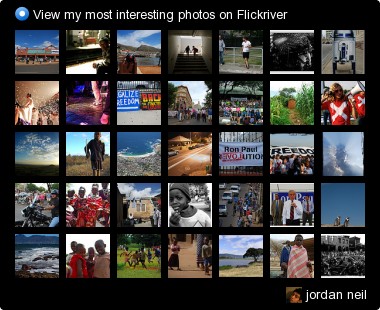
 As South Africa evolves further and further away from its tumultuous past, citizens are arming themselves with their freedom to communicate. South Africa is one of Africa’s leading media centers with a diverse population. After apartheid ended in 1994 and the Bill of Rights was enacted in which guarantees that every citizen has the right to freedom of expression, which includes freedom of the press and media, the freedom to receive or impart information or ideas, etc. With South Africa undergoing an infrastructure upgrade to include online, wireless, and satellite connectivity, subscribers and users are on the rise. Subsequently, this increase in wireless technology has catapulted Africa to be one of the fastest growing mobile markets in the world. Online and wireless technologies aren’t perfect as there continues to be a disproportionate amount of poverty resulting in a vast majority of people remaining without reliable connectivity and technology capabilities.
As South Africa evolves further and further away from its tumultuous past, citizens are arming themselves with their freedom to communicate. South Africa is one of Africa’s leading media centers with a diverse population. After apartheid ended in 1994 and the Bill of Rights was enacted in which guarantees that every citizen has the right to freedom of expression, which includes freedom of the press and media, the freedom to receive or impart information or ideas, etc. With South Africa undergoing an infrastructure upgrade to include online, wireless, and satellite connectivity, subscribers and users are on the rise. Subsequently, this increase in wireless technology has catapulted Africa to be one of the fastest growing mobile markets in the world. Online and wireless technologies aren’t perfect as there continues to be a disproportionate amount of poverty resulting in a vast majority of people remaining without reliable connectivity and technology capabilities.

 It would be beneficial for
It would be beneficial for
 South Africans to get a different perspective on how the rest of the world lives, bringing both worlds closer to each other. Social media by its very nature is more open, authentic and transparent—and, for better or worse, not ruled by the same norms as mainstream media.
South Africans to get a different perspective on how the rest of the world lives, bringing both worlds closer to each other. Social media by its very nature is more open, authentic and transparent—and, for better or worse, not ruled by the same norms as mainstream media.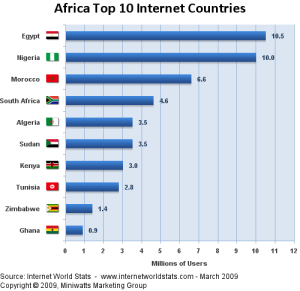 fourth on a continent that has seen an increase in internet use growth of 1100% between 2000 to 2008 compared to 332.6% in the Rest of the World for the same period.
fourth on a continent that has seen an increase in internet use growth of 1100% between 2000 to 2008 compared to 332.6% in the Rest of the World for the same period.
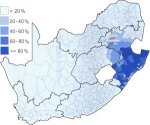



 According to Stephen Newton’s
According to Stephen Newton’s  According to Patricios only 15% of consumers trust advertising, compared to 72% who trust what others tell them about products, therefore, bloggers in the RSA can exponentially increase the reach of your message and the equity of your brand among African consumers via mobile and online social networks like Mpesa, Celpay and Etranzact in ways unmatched by any other medium.
According to Patricios only 15% of consumers trust advertising, compared to 72% who trust what others tell them about products, therefore, bloggers in the RSA can exponentially increase the reach of your message and the equity of your brand among African consumers via mobile and online social networks like Mpesa, Celpay and Etranzact in ways unmatched by any other medium.








 However, one company –
However, one company – 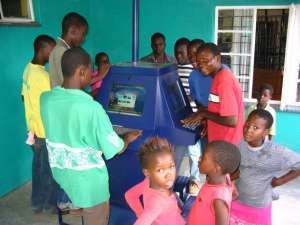 My research came across a joint project by the Department of Science and Technology (DST) and CSIR Communications called
My research came across a joint project by the Department of Science and Technology (DST) and CSIR Communications called 

 I think that this program is a positive first step towards empowering a disconnected population and giving them a chance to have a dialogue with the rest of the world. ^JT
I think that this program is a positive first step towards empowering a disconnected population and giving them a chance to have a dialogue with the rest of the world. ^JT o present information specifically related to African news, video and content. Brands that are looking toward South African audiences as a marketing strategy can use Afrigator to post to the several thousand African blogs, podcast, and videos already on the site.
o present information specifically related to African news, video and content. Brands that are looking toward South African audiences as a marketing strategy can use Afrigator to post to the several thousand African blogs, podcast, and videos already on the site. 


 In the blogosphere, South African membership far outweighs African sites on
In the blogosphere, South African membership far outweighs African sites on  scroll through an
scroll through an 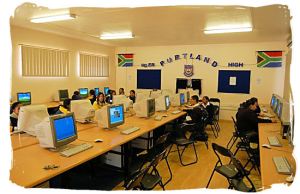
 Ubuntu
Ubuntu